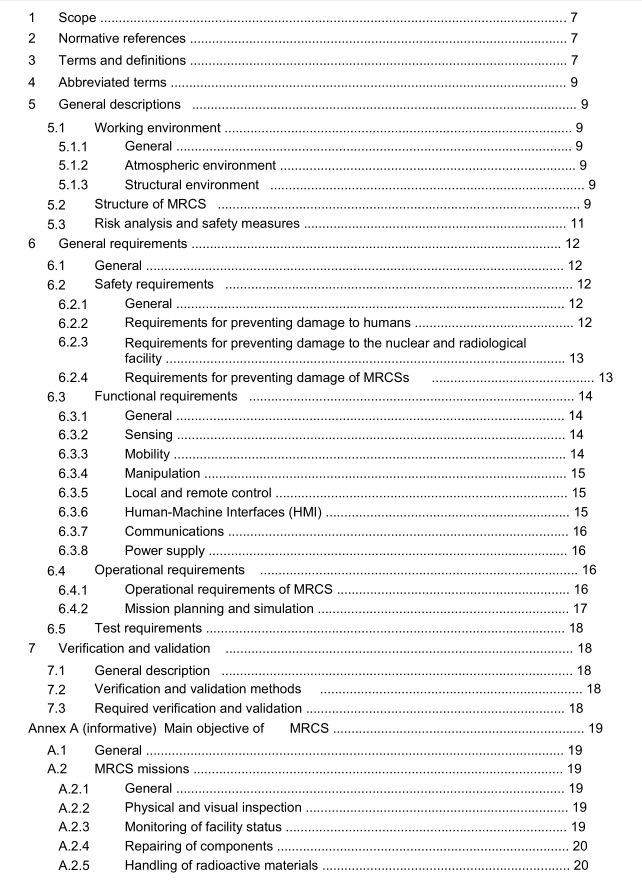IEC 63048 pdf – Mobile remotely controlled systems for nuclear and radiological applications – General requirements

IEC 63048 pdf – Mobile remotely controlled systems for nuclear and radiological applications – General requirements
Safety protection and working procedures also need to be considered.
Safety protection includes the use of safety devices and recognition measures.
6 General requirements
6.1 General
The MRCS shall be designed and manufactured to meet the requirements for given missionstaking into consideration the environmental factors specified in 5.1.
These requirements consist of the safety, functional, operational and test requirements;- Safety requirements (6.2)
Functional requirements (6.3)Operational requirements (6.4)- Test requirements (6.5)
6.2Safety requirements6.2.1General
The MRCS shall be designed to safely complete the mission in the working environmentmentioned in 5.1.The safety of MRCS should be verified in three different aspects.
MRCS should be designed to limit the level of risk that may cause health damage tohumans while all the time using MRCS,including the pre-processes (e.g.,preparation,installing,master and setting up the master station),the main processes (e.g.,remoteoperation of mobile base, remote controlling of manipulator). and the post-processes (e.g..
retrieving, decontaminating, maintaining, and repairing the MRCS).
MRCS should be designed to limitthe level of risk to cause damage to the externalenvironment. MRCS should be safely retumed without causing damage to the environment
during the mission.
MRCS should be designed to protect itself from the dangers of the external environment.MRCS should be safely returned without failure during the mission.
Depending on the workingenvironment, the specific safety requirements should beconsidered. AnnexB provides a safety verification tool to ensure that the MRCS concernedcan be applied in a specific mission environment. The manufacturer shall provideperformance specifications and relevant information.
6.2.2 Requirements for preventing damage to humans
The MRCS shall be designed in such a way as to guarantee safety of humans all the timewhile utilizing it. The level of risk imposed on humans while working on the MRCS shall bereduced to a level below the allowable limit. lf applicable,it is necessary to consider issuesthat include, but are not limited to, the following items.
MRCS should be designed to mitigate all possible risks,as identified in 5.1, to a levelbelow the allowable limit, if they have reached the level where humans could be harmed.
MRCS should be designed to warn of the risks to humans,while preparing,installing,operating,retrieving,decontaminating,inspecting,maintaining,repairing,or utilizing theMRCS for other purposes.
MRCS operating procedures should be clearly defined and documented. The possiblerisks in each procedure and the way to mitigate those should be described.
.MRCS should be designed not to harm humans in case of collision or contact with it, due
to its physical properties (speed and force) or electricall properties.
·MRCSs should be designed to guarantee the safety in repairing or maintenance. Amodular design that allows the user to simply replace the failed module is desirable toreduce the risk.
.MRCSs should be designed in such a way that they are not easily contaminated.
·The MRCS should be decontaminated after finishing a mission so that humans can access
the MRCS in order to maintain or repair it after the decontamination.
. MRCS should be designed to firmly fix all parts to prevent the separated parts which harm
humans.
6.2.3Requirements for preventing damage to the nuclear and radiological facility
The level of potential risk to the nuclear and radiological facility while working on the MRCSshall be reduced to a level below the allowable limit. lif applicable,issues should beconsidered, including but not limited to the following.
. The entire task should be performed so as not to damage the structures in case ofunexpected falling or rollover of the MRCS.
‘ The entire task should be performed so as not to damage the structures in case of
unexpected collision with the structures. The operating speed shall be limited enough toreduce the possible risk.
The entire task should be performed so as not to damage the structures in case ofintended contact. The contact stress exerted on the structure should be kept below theallowable stress lirmit.
– The entire task should be performed so as not to generate foreign substance in order
to prevent damage to the structure or disturbing normal operation of nuclear facility .Manipulation should be carefully done not to drop the handling object.
– Inspection should be conducted to find foreign objects.
-The foreign objects may be removed, if detected.
6.2.4Requirements for preventing damage of MRCSs
The MRCS should complete the given mission safely without causing any damage untilreturning to a pre-defined position. lts mission should be terminated if a failure occurs. TheMRCS should return to a ‘pre-defined position for repairing,or it should halt safely at theposition in case it is impossible to returm. The MRCS should be designed so as to provideappropriate safety measures and to minimize degradation of performance, in consideration of
the working environment as specified in 5.1.
The level of risk to MRCs shall be reduced to a level below the allowable limit. The MRCSshall be designed, manufactured, and operated while taking into consideration, but not limited
to , the following requirements.
.MRCS should be designed so as to provide redundancy and diversity to reduce the risk incase of malfunction, performance degradation, and failure of the device.
MRCS should be radiation tolerant or hardened, if necessary.
Subsystem, module or assembly in MRCS should be waterproofed, if necessary.
Subsystem,module or assembly in MRCS should be designed so as to prevent thedegradation due to dust, if necessary.
Subsystem, module or assembly in MRCS should be designed so as to minimize inducingvibration, and anti-vibration measures should be applied, if necessary.
Subsystem,module or assembly in MRCS should be designed so as to guarantee themechanical strength and to reduce friction, if necessary.









